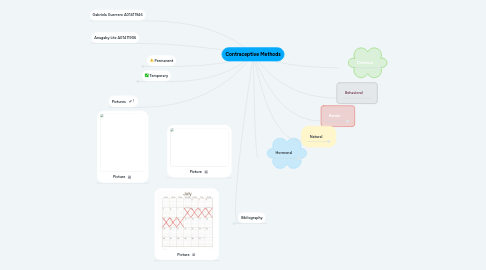Contraceptive Methods
by Gabriela Sofía Guerrero Flores

1. Permanent
1.1. Sterilization (Tubal ligation)
1.2. Vasectomy - Lasts for life.
2. Temporary
2.1. Low maintance
2.1.1. Birth control Implant - 5 years.
2.1.2. IUD - 3-12 years.
2.2. Used on schedule
2.2.1. Birth control shot - every 3 months.
2.2.2. Birth control patch - weekly.
2.2.3. Birth control pill - daily.
2.2.4. Condom -every time.
2.2.5. Internal condom - every time.
2.2.6. Spermicide - every time.
2.3. Lifestyle
2.3.1. Withdrawal (pull out method) - Every time.
2.3.2. Breastfeeding as birth control - Do every 4- 5 hours.
2.3.3. Outercourse or abstinence - every time.
3. Gabriela Guerrero A01411946
4. Anagaby Litz A01411906
5. Pictures
6. Bibliography
6.1. Trussell J, Aiken ARA, Micks E, Guthrie KA. Efficacy, safety, and personal considerations. In: Hatcher RA, Nelson AL, Trussell J, Cwiak C, Cason P, Policar MS, Edelman A, Aiken ARA, Marrazzo J, Kowal D, eds. Contraceptive technology. 21st ed. New York, NY: Ayer Company Publishers, Inc., 2018.
6.2. Peragallo Urrutia R, Polis CB, Jensen ET, Greene ME, Kennedy E, Stanford JB. Effectiveness of fertility awareness-based methods for pregnancy prevention: A systematic review
6.3. . Obstet Gynecol 2018;132:591-604.
7. Picture
8. Picture
9. Picture
10. Barrier
10.1. Diaphragm cap— The caps are placed inside the vagina to cover the cervix to block sperm. Before sexual intercourse, you insert them with spermicide to block or kill sperm.
10.2. Sponge—A contraceptive sponge contains spermicide and is placed in the vagina where it fits over the cervix.
10.3. Male condom— The condom keeps sperm from getting into a woman’s body. Latex condoms, the most common type, help prevent pregnancy, and HIV and other STDs, as do the newer synthetic condoms.
10.4. Spermicides—These products work by killing sperm and come in several forms—foam, gel, cream, film, suppository, or tablet. They are placed in the vagina no more than one hour before intercourse.
10.5. Female condom—It helps keeps sperm from getting into her body. It is packaged with a lubricant and is available at drug stores.
11. Chemical
11.1. Copper IUD—Women can have the copper T IUD inserted within five days of unprotected sex.
11.2. Emergency contraceptive pills—Emergency contraceptive pills up to 5 days after unprotected sex, but the sooner the pills are taken, the better they will work.
12. Natural
12.1. Female Sterilization— Tubal ligation or “tying tubes” A woman can have her fallopian tubes tied so that sperm and eggs cannot meet for fertilization. The procedure can be done in a hospital or in an outpatient surgical center.
12.2. Male Sterilization–Vasectomy operation is done to keep a man’s sperm from going to his penis, so his ejaculate never has any sperm in it that can fertilize an egg. The procedure is typically done at an outpatient surgical center.
13. Hormonal
13.1. Implant—The implant is a thin rod that is placed under the skin of a woman's arm. This rod contains a progestin that is expelled for 3 years into the body
13.2. Injection shot — Hormone progestin shot can be placed in à womens arm or rear every three months by their doctor
13.3. oral contraceptives— An oral contraceptive known as the pill contain estrogen and progestin.
13.4. Progestin only pill—Unlike the combined pill, the progestin-only pill only has one hormone, progestin. It is prescribed by a doctor. It may be a good option for women who can’t take estrogen.
13.5. Patch— A skin patch can be worn on the lower abdomen, buttocks, or upper body (but not on the breasts). This method is prescribed by a doctor. It releases hormones progestin and estrogen into the bloodstream.
13.6. Hormonal vaginal contraceptive ring—The ring releases the hormones progestin and estrogen. You place the ring inside your vagina.
14. Behavioral
14.1. Fertility awareness-based methods is understanding your fertility pattern
14.2. Lactation Amenorreah Method For women who have recently had a baby and are breastfeeding, LAM can be used as birth control when three conditions are met: 1) amenorrhea (not having any menstrual periods after delivering a baby), 2) fully or nearly fully breastfeeding, and 3) less than 6 months after delivering a baby



